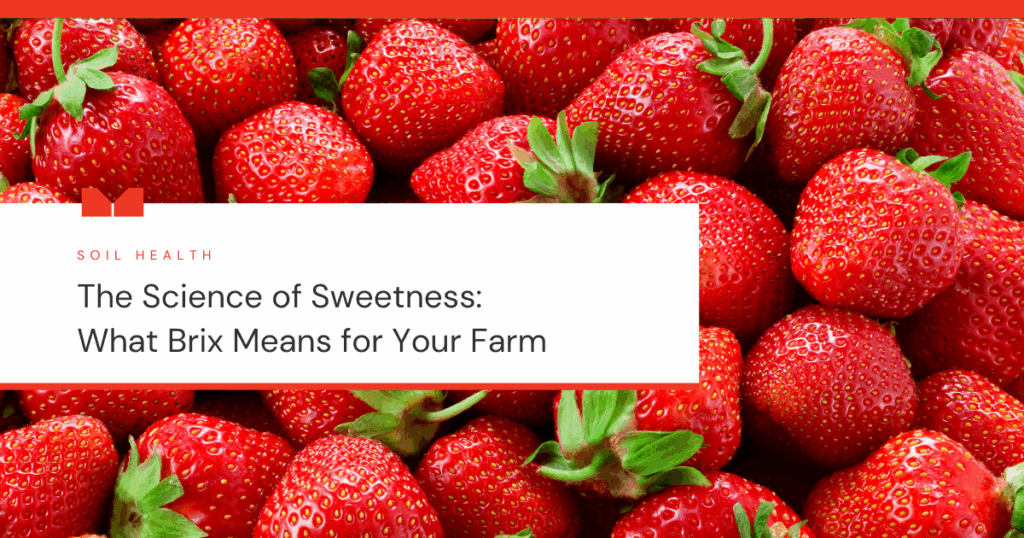
The Science of Sweetness: What Brix Value Reveals About Your Crops
Ever bitten into one strawberry and thought it tasted a little bland, only to then try another one that was bursting with flavor? That difference isn’t just luck; it’s science. The secret to the sweetness of the second strawberry is a higher Brix value.
Brix value is the sugar content in a crop’s juices, and it’s a key indicator of plant health, nutrition, and crop quality.¹
Brix is the name for a unit of measurement used to determine the sugar content in plant sap, juice, or other liquids. It was developed by German scientist Adolf Brix in the 1800s and is used across industries to assess sweetness and quality.¹
As a reflection of a plant’s internal health, Brix isn’t just about taste. It’s quickly becoming one of the most important field measurements in sustainable agriculture. A high Brix value means a plant has more natural sugars and nutrients in its sap. This usually means the plant is efficiently making energy from sunlight through photosynthesis and producing healthier crops for farmers.²
In this post, we’ll explore how Brix impacts a farm’s bottom line, how to increase Brix values in plants, and why it’s an essential measurement tool to monitor plant health.
Why does Brix matter?
Brix value gives farmers a fast, clear snapshot of how well a crop is photosynthesizing and storing energy. Traditionally used to measure sugar concentration in beekeeping, brewing, and winemaking, Brix value is also a go-to indicator in fruit and vegetable farming.¹
High Brix values usually signal:
- A sweeter, more flavorful crop¹
- Greater nutrient density³
- Balanced nutrition within the plant, which results in greater resistance to pests and disease⁴
Research connects Brix value and plant quality, making it a metric for profitability.¹ Growers can enhance the Brix value in their crops by improving soil health.
How is Brix value measured?
Brix value is measured using a tool called a Brix refractometer. A drop of plant sap is placed on the refractometer’s glass surface, and when sunlight passes through the liquid, it bends (or refracts), and the tool measures the sugar content based on this change in light refraction.¹
Using a Brix refractometer is simple:
- Cut a leaf or fruit sample
- Squeeze out the juice (some farmers use garlic presses)
- Place a drop on the glass
- Close the lid and look through the eyepiece to read the Brix level
Farmers use refractometers to evaluate crop readiness, detect nutrient issues, and compare plant varieties. For example, a watermelon with a Brix value above 11 is generally market-ready, while leafy greens might hover around 6–9 depending on soil and climate.¹
How is Brix value related to plant health?
Brix values give us insights into plant and soil health. The healthier the soil, the better plants are able to photosynthesize, which makes plants healthier and thereby leads to higher sugar levels (i.e. Brix values).²
High Brix values are achieved thanks to factors such as:
- Maximized photosynthesis. More energy produced equates to more sugar being produced and stored.²
- Improved nutrient cycling. Brix values reflect a plant’s ability to absorb and convert minerals into usable energy.⁵
- Water availability. Healthy soil acts like a sponge, soaking up rainfall and irrigation, so plants have water when they need it most.²
Many in the agriculture industry view Brix values as a snapshot of a holistic system encompassing soil health, microbial activity, nutrient availability, and water management. A high Brix value is a sign that the plant is efficiently receiving nutrients in its soil to actively support biological life.⁵
Can farmers increase Brix values?
Yes, especially when improving soil health.⁵
Healthy, living soil is the secret to sweeter, more vibrant plants. When soil is packed with organic matter and friendly microbes, roots grow stronger and can soak up water and nutrients more easily. Those nutrients from the microbes power the plant’s ability to turn sunlight into energy, which means more sugars are made and stored within the plant.²
As microbes break down leftover plants and roots, nutrients are released. It’s a self‑reinforcing cycle: rich soil feeds the plant, and a thriving plant feeds the soil.
Farmers looking to improve Brix over time can start with programs that improve soil health, like introducing microbial support, optimizing irrigation, and reducing inputs that suppress soil biology.⁵ MyLand has been shown to help increase Brix values in crops like strawberries. In 2024, one such farm in Florida increased Brix values by 13 percent.
Brix values & plant health
Brix values reflect the health of plants, the vitality of soil, and can at times even paint a picture of a farm’s potential profitability.⁵ Higher Brix values indicate that soil biology is active, nutrients are available, and the entire system is working in harmony.
MyLand assists growers in improving soil health by introducing live, native microalgae through existing irrigation. This process naturally enhances microbial life, improves nutrient cycling, and lays the foundation for higher Brix values.
Want to learn more about how MyLand can help your farm? Reach out and start improving soil health and crop value from the ground up.
Sources
- Ohio State University Extension. “Using Refractometers to Measure Fruit and Vegetable Quality.” Link
- Kusumastuti, A. et al. (2021). Dry Land Sustainable Agriculture with Application of Sorgaab to Improve Brix Sugar Content and Crop Yield in Two Sorghum Varieties. IOP Conference Series: Earth and Environmental Science, 752(1), 012006. Link
- Ohio State University Extension. “What is Brix?” Link
- Gu, S. (2010). Is High Brix for Vegetables Valid? University of Missouri IPM. Link
- Niu, Y., et al. (2021). Diversity of microbial communities and soil nutrients in sugarcane rhizosphere soil under water-soluble fertilizer. PLoS ONE, 16(1), e0245626. Link